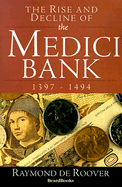|
|
|
|
||||||

|
The Rise and Decline of the Medici Bank: 1397-1494
By Raymond A. de Roover 1999/08 - Beard Books 1893122328 - Paperback - Reprint - 524 pp. US$34.95 The fascinating story of this financial monolith which exerted great influence in its time. Publisher Comments A classic history of banking and trade in the medieval period, combining superb research and analysis with graceful writing. The Medici Bank was the most powerful banking house of the 15th century. Headquartered in Florence, Italy, it established branches in Rome, Venice, Geneva, Lyons, Bruges, London, and many other cities. The bank served as financial agent of the Church, extended credit to monarchs, and facilitated international trade in Western Europe. By their personal influence and the use of their profits, the owners and administrators of the bank contributed significantly to the development of Florence as the greatest center of the Renaissance. Review by Susan Pannell It's the name on the door that grabs you. The Medicis were wheeler-dealers extraordinaire. From modest beginnings as tradesmen in the thirteenth century, they became dukes of Tuscany, the richest family and de facto governors of Florence, builders of monuments (often to themselves - for example, the church of San Lorenzo), and compilers of an excellent library that still exists (the Biblioteca Laurenziana). Their political power shaped history: two Medicis sat in the Vatican; Machiavelli dedicated The Prince to a Medici, Lorenzo the Magnificent, in vain hopes of getting his job back; and the Medicis may have been indirectly responsible for the invasion of Italy in 1494 by Charles VIII of France. Despite their colorful splash in history, the Medicis' activities as bankers and traders have received less scrutiny - oddly, in view of the fact that it was financial power that quite literally bankrolled everything, Economic historian Raymond de Roover puts business first in this book, a classic analysis of medieval period banking and trade. Founded by Giovanni di Bicci de' Medici, the Medici Bank was the most powerful banking house of the fifteenth century, achieving its zenith in the years from 1429 to 1464 when Cosimo was in charge, and then skidding for the thirty years between his death and the expulsion of the Medici family from Florence in 1494, From its headquarters in Florence, the bank established branches everywhere that mattered. It served as financial agent of the Roman Catholic Church, extended credit to monarchs, and facilitated international trade in Western Europe. By their personal influence and the use of their profits, the owners and administrators of the bank contributed significantly to the development of Florence as the greatest center of the Renaissance. As the author points out, a study of the Medici Bank is worthwhile from a microeconomic perspective as well. In the pre-industrial era of the Medicis, banking and trade were synonymous with big business - there was nothing bigger. While the techniques of modern business have changed in the past five to six hundred years, most notably in methods of communication, the human resources problems confronting business today are remarkably similar to those the Medicis wrestled with centuries ago; how to select the right manager for the right job, how to coordinate different branches and departments, when to retain personal control and when to delegate. The bank used the best methods available for handling every business problem, representing, therefore, not a typical business of the time but rather the optimum that was achieved in the Middle Ages and the Renaissance. Despite their stature, however, the Medicis were not immune to unfavorable economic conditions or political forces, such as organized consumer groups and the climate created by the War of the Roses in England. The book combines superb research and analysis with graceful writing, The numerous illustrations, diagrams, charts and tables (including genealogies), drawn from archival material, make this work as valuable now as when it was first published in 1963. Review by Susan Pannell Raymond de Roover was born in Belgium, and earned an MB.A. from Harvard and a Ph.D. from the University of Chicago. He earned the reputation of being a great Flemish historian when he wrote various books including The Rise and Decline of the Medici Bank He was a professor at the Harvard Graduate School of Business.
|
|
|
|
home
| about us
| contact us
| related
sites |